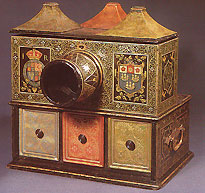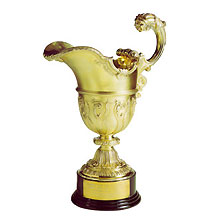Historic Collection
In the course of its long history, the Saddlers’ Company has amassed a great store of valuable items, usually bequeathed by members. Despite the destruction of the Hall on three occasions, resulting in the loss of much property and subsequent financial difficulties, many fine treasures remain to this day in the Company’s collection.
The Ballot Box
The ballot box, probably the oldest English example in existence still in use, is a rare specimen of Jacobean workmanship. It is made of wood, painted with the elaborate centipede scroll which Indian craftsmen of the period had adopted from earlier Korean and Chinese designs. It bears the date 1619. It has been in regular use since at least 1676 for the annual election of wardens, although the archives of the Saddlers’ Company suggest that secret ballot was in use as early as 1610.The box contains three drawers, which may be used to receive ballots. The voter places his hand into the central funnel and, by turning the wrist, allows his vote to pass, unseen, into the drawer of his choice. The Ballot Box was made for the General Court of Election of the East India Company, founded by Royal Charter in 1600.
The operations of the Company’s earlier years were not successful and the merchants, entrusted with its success, became restive at their exclusion from the Committees, as the board of directors was then called. They felt that at the Company’s Court of Elections, when balloting by show of hands, the result would always be the election of Court favourites and other powerful men of the day. Thus the only chance of their representatives being elected was to have a secret ballot.
Accordingly, the ballot box was made and produced at the Court of the East India Company’s Election in 1619. Its use, however, was rejected by the Committee and the King himself (James I) intervened, declaring that “He would have no Italian tricks brought into his Kingdom”.
What happened to the box after this is not known, nor how it came into the possession of the Saddlers’ Company, but there is a first reference to it in the Audit Book in 1676. It is possible that it was produced as a replacement for an earlier box that had been destroyed in the Great Fire.
The Mace
The Mace is a visible sign of the royal authority delegated to corporate bodies which have been granted royal charters. As such, it is used both for ceremonial and administrative purposes. When carried in procession, it identifies those empowered to act on behalf of the corporate body concerned. When laid on the table in front of the Chairman at meetings it signifies the legal authority under which business is being conducted.
The Porter Ewer
A silver-gilt replica of a ewer by Paul de Lamarie, the helmet shaped body applied with foliate straps on a matted ground, flying scroll handle with mask terminal.
Horace Porter, prime warden in 1916, presented this ewer to the company in memory of his father, Frederick William Porter, Master in 1895.
The Fisher Cup
This is a tall standing or “Loving Cup” and cover in silver gilt. It is richly chased and bears the arms of the Company and of the donor, with the figures of two horses saddled. The intervening spaces are filled in by the acanthus form of decoration, so common at the period. The cover is cone shaped, like that of the “Dashwood” Cup, and is surmounted by a horse, saddled and bridled. Under the rim of the cover is inscribed, ‘Ex dono Guilielmi Fisher generosi in memoriam patris sui Edwardi Fisher olim hujus Societatis membri, Anno Domini 1662’.
The Benskin Salt
A Charles II ‘pulley’ or ‘bracket’ standing salt of circular capstan shape. The base is engraved with the Company’s arms and the underside inscribed ‘The Gift of Edward Benskin, A Member of this Company, The 18 September 1690’ . Although the Company did not receive this piece until 1690, the fact that it was made in 1661 places it among the Company’s few remaining pieces of pre-Fire plate.
Edward Benskin worked as a master saddler in St Agnes Lane, now part of Gresham Street, following his admission to the Livery in 1645. He became an Assistant in 1656 and was Master in 1664 and again in 1665, serving subsequently as a warden in 1674, 1677 and 1678. He was a churchwarden, auditor and vestryman in the parish of St Anne and St Agnes, an officer of the Ward of Aldersgate Within and a Common Councilman. He died in June 1696.
The Funeral Pall
The Company’s Funeral Pall dates from about 1508 and is made of Spanish brocaded velvet with English embroidery in gold and silver thread. The style of the embroidery links the Pall with the Fraternity of Saddlers of the Assumption of the Blessed Virgin Mary, which flourished at St Vedast’s church from the 15th Century until the Reformation and the subsequent abolition of chantries. The later defacement of the Virgin was a gesture which enabled the Company to continue using the Pall in Protestant ceremonies. Upon the death of a brother or sister of the Company, the corpse was taken into Saddlers’ Hall where the coffin was covered with the Pall, or Hearse-Cloth as it was sometimes called. This practice ceased during the Commonwealth (1649-60), where after the Pall was placed instead on the table at the Quarter Court immediately following the death of an Assistant. This procedure was followed until the early part of the 20th Century when the fabric was becoming too fragile. It is now kept in a glass case and protected from disturbance and light.
The Dashwood Cup
This is a handsome silver gilt standing Cup, or “Loving Cup”. On the sides of the Cup, which are plain and frosted, are three panels, containing the arms of the Company, the arms of the donor, Alderman Sir Francis Dashwood, Master in 1653, and the inscription ‘The gift of Sir Francis Dashwood to the Worshipful Company of Saddlers, London, May, 1654’. The cover is cone-shaped and surmounted by a horse, saddled and bridled (the Company’s crest).
The Coconut Cup
This is a Flemish silver-gilt mounted coconut cup and cover, carved between three caryatid straps engraved at the lips with arabesques. It has a lobed vase-shaped stem with a spreading foot chased with swans and aquatic monsters. The cover is chased with figures below the finial. The sides of the coconut are beautifully carved in three tableaux, representing the Annunciation, the Adoration of the Magi, and the Nativity. Only faint traces remain of the Antwerp and year marks (circa 1560) but the makers mark, the Pipes of Pan, is clearly visible.
Robert Labourne, who was Master in 1615 and again 1616, died in 1627. In his will he bequeathed “one peece of plate being a graved nutt with a cover chased guilt” to the Company, and the minutes of the Court for 20th September 1627 record that “at this Court was brought to this fellowship one cup of a nutt chased being given by the last will and testament of Robert Labourne”.
The Cup has been exhibited in Antwerp twice since the end of the second world war at major exhibitions of Flemish art.
Labourne was one of the early benefactors of the Company. In 1624 he gave properties in Serjeant’s Inn and Lombard Street to the Master and wardens, directing that the income should be used “to pay 10 pounds to twenty poor men of the Company, with 10 shillings to be paid to the Clerk, 10 shillings to the Junior Warden and 3 shillings 4 pence to the Beadle”. Any balance was to be used “for such charitable and pious purposes as the company shall think fit”. Labourne’s Charity as part of Kaye’s and Labourne’s Charity exists to this day and is administered by the Company on behalf of the Charity Commission for the relief of hardship and distress among the Freemen of the Company, and thereafter for such charitable purposes as the Company sees fit.
The King’s Champion Saddle
The Kings Champion Saddle is held on loan in Saddlers’ Hall due to the generosity of the present Queen’s Champion, Lord of the Manor of Scrivelsby. The saddle, of leather covered with red silk velvet and ornamented with silver-gilt lace, braid and fringe, was probably used at the Coronation of George the Third in 1760. Together with the bridle and gauntlet, it was restored in Saddlers Hall some 200 years later by John Waterer, a Liveryman of the Company.The Manor of Scrivelsby in Lincolnshire carries with it the hereditary title of the Grand Champion of England. The Dymoke family has held the title since 1292. The Champion’s duty was performed only at the Coronation of each Monarch, with the last such ceremony taking place at the Coronation of King George IV in 1821. Clad in full armour, carrying a gauntlet and attended by trumpeters, Serjeants-at-Arms, a Herald and the Lord High Constable, the Kings’ Champion rode into Westminster Hall and delivered a challenge against anybody who might gainsay the Sovereign. After the third challenge, their being no response, the Monarch would toast the health of the Champion, in the knowledge that he was undisputed as Sovereign.
Related News
Prime Warden calls in on St Georges Paramedic Simulation Centre
A group of Saddlers were privileged to join Caroline Neveu and the team at the St Georges Hospital […]
Learn MoreSophie Sperling wins Equine Fitter of the Year Award at British Equestrian Trade Association International Fair
Master Saddler John Robinson joined over 300 attendees at the recent BETA Awards Dinner at the NEC to […]
Learn MoreCamilla Lywood presents cheque for £34,000 to Sheila Scott of Shelter from the Storm
After 12 months of fundraising by Members of the Saddlers Company – including bike rides, charity evenings, wine […]
Learn MoreNew Saddler’s Company Award developed with Cockpit Studios
We’re proud to announce that applications are now open for the brand-new Saddlers’ Award — closing Tuesday 30 […]
Learn MorePony Club Chair Tim Vestey calls in on Master Saddler Godfrey Morris
The National Pony Club Championships once again played host to Master Saddler Godfrey Morris who offered demonstrations and […]
Learn MoreMembers call in to Blenheim to check up on Saddlers’ Copse
74 members, family and friends visited Blenheim Palace in order to check up on progress at the Saddlers’ […]
Learn More
















